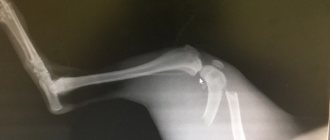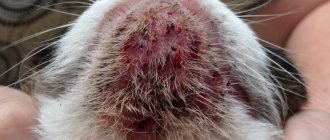Balancing, developing speed, intimidating enemies and even thermoregulation - all these functions in cats are performed by the tail. It contains many nerve endings, which is why the tail is often called an indicator of a pet’s mood.
However, serious damage to it can lead to a fracture. How to recognize an injury in a timely manner? What actions should I take? Specialists from a veterinary clinic in Moscow talk about everything in more detail.
See this article:
Common causes of fractures Signs of a fracture Types of fractures Diagnosis by a veterinarian Treatment: methods and effectiveness
- Gypsum
- Amputation
- Drug therapy
Prevention
Why is a broken tail dangerous for cats?
An anatomical feature of the tail is the fact that it consists of a large number of bones and vertebrae and is replete with the presence of nerve endings and blood vessels. The role of the tail in a cat’s life is difficult to overestimate: with its help, she determines distance and balances when passing through narrow surfaces.
Any animal can be injured, especially if it is a kitten or cat that often walks outside
Symptoms: how to determine if there is a problem
Why does a dog chew its tail until it bleeds: what to do
The fact that something is wrong with a cat’s tail will be visible to the naked eye. A crease or unnatural bend will be visible at the site of injury. Also, often when injuries occur, the innervation is disrupted, and the animal is unable to move the injured part.
The main signs of possible problems with a cat's tail are:
- visually noticeable fracture or disruption of integrity;
- pain when trying to touch the animal;
- traces of a bite, injury or infection are visible on the tail;
- a clearly noticeable inflammatory process and an increase in temperature, which can be detected even with a simple touch;
- the damaged part of the tail swells and swells;
- the tail hangs unnaturally;
- an open injury in which the bones are gaping;
- ensuing paralysis;
- problems with motor function of the legs are noticeable;
- problems with the toilet (either urinary and fecal incontinence appears, or the cat cannot defecate on its own).
An examination by a specialist will help you understand whether there is a fracture or whether it is a simple bruise.
Mechanical injuries
One of the most common groups of pathologies. Most often, something wrong happens to the tails of cats that regularly walk outside. It happens that pets get their tail pinched by a door, in other cases they lose it in fights with other cats or as a result of dog attacks. It happens that cyclists or children run across a tail carelessly laid out on the road... In short, there are a lot of causes of mechanical injuries.
It is easy to notice them: the tail becomes “flaccid”; the cat cannot (and does not want, since it is in great pain) to move it. Please note that not all cases show visual signs of crushing or fracture. At first glance, the organ may appear intact.
The clinical picture is quite specific and easily noticeable:
- When trying to take a cat's tail, its owner reacts extremely nervously and even aggressively.
- The organ can be bent at a completely unimaginable angle to the horizon.
- In the most severe cases, when the injury was really serious, not limited to the tail, urinary/fecal incontinence may occur. This is a very bad sign, indicating either some kind of infection (in advanced cases), or damage to the sacral spine.
Diagnosis and treatment
The specialist will carefully examine your pet's tail and also conduct a series of neurological tests. The latter make it possible to understand whether the animal’s nervous system is damaged. In particular, if the cat has no tail sensation at all, treatment options will be limited.
The following types of diagnostic tests are recommended:
- Complete blood test, including checking its biochemical status.
- Analysis of urine.
- It is necessary to perform radiographs of the sacral and caudal spine. Often, after taking a photo, it becomes clear what exactly happened to the pet.
Treatment, as we said above, depends on the underlying cause identified by a veterinarian.
- In cases where the injury is not serious (mild bruise), simple rest will help.
- In more severe cases, it is often necessary to resort to amputation of the affected part of the body.
Note that when the tail is dislocated, it is often possible to confine itself to its reduction: other medical care (as a rule) is no longer required after this. Even with wounds, it rarely comes to surgery. If, of course, the owners at least somehow provided assistance to their pet.
How to distinguish a fracture from a tail bruise
A cat's tail fracture is accompanied by severe pain. Whenever you try to feel the tail, she will start screaming and struggling, but with an ordinary bruise this does not happen.
The cat has a swollen paw and is limping: what to do?
In addition, with a fracture and damage to the integrity of the vertebrae, the deformation of a certain part is clearly visible, which is not observed with a bruise.
For your information! Bruises occur much less frequently than fractures, since the vertebrae in the animal’s tail are very delicate and are easily damaged when subjected to strong pressure.
Violation of tissue integrity
Tissue damage resulting from a bite, cut, blow or other injury is visible visually and in most cases does not require hardware diagnostics. If a cat’s tail hurts very badly or the wound is extensive, the pet should be taken to the clinic immediately.
First aid: hydrogen peroxide for disinfection, sterile bandage to stop bleeding and prevent infection. Small abrasions, scratches and other wounds can be treated with any antiseptic ointment (for example, levomekol). But the cat still needs to be shown to a doctor, since even a small scratch can cause infection, tissue necrosis, sepsis and other “delights” of self-medication.
Diagnosis of tail fractures
What does a cat’s tail “say”: let’s look at all the positions
A cat's tail fracture must be diagnosed by a doctor. Even if the damage is obvious, the specialist must find out which part of the tail is damaged and assess how serious the pet’s general condition is. And based on the results of the examination, an individual decision is made on the methods and methods of treatment.
Most often, the veterinarian will need to take an x-ray to make a correct diagnosis. This will allow you to more accurately determine the location and extent of the injury.
If the animal's symptoms are more severe, then if there is a problem with the motor ability of the hind legs or with stool, blood and urine tests, as well as an ultrasound, will have to be done. This will make it possible to assess the risks and prognoses for the health and life of the animal. In addition, this can exclude the presence of damage to other nearby organs, for example, a fracture of the sacrum.
With a complicated fracture, the cat will not be able to sit or move around.
Why don't people like cats in Vietnam?
What is this connected with? There are several opinions.
The sonorous and drawling manner of speech of the Vietnamese, in itself, resembles meowing, and the cat’s “meow” is consonant with the Vietnamese word for “poverty”, so superstitious people, not wanting to listen to constant reminders of the deplorable state of affairs, found a way out - simply cats at home don't start. Therefore, this is not so much a manifestation of personal sympathy as submission to superstition. On the one hand, they can be understood - it’s easy to give up under such parting words. There is another version: the Vietnamese believe that cats imitate a child’s cry with their meows and can lure a person to a dangerous place. But this option sounds far-fetched and unlikely.
In its peculiarity, Vietnam is reminiscent of Egypt: although cats are revered there, the Vietnamese also show a kind of exceptional attention, endowing animals with powers that they do not have.
Is it possible to treat on your own?
Many pet owners who have encountered the problem described remember their confusion in the first minutes when they discovered that the cat’s tail was broken and were at a loss what to do. You need to realize that if we are talking about a fracture, then you cannot do without the help of a specialist. It is the veterinarian who will make the correct diagnosis and prescribe the necessary treatment.
At home, you can try to treat a dislocation yourself (if you are confident in the diagnosis) or a fracture not complicated by displacement. In this case, a tight bandage of a special fixing bandage is applied to the damaged area, which will protect it from unnecessary movements. The bandage is applied for 3 weeks.
But in this case, you need to be prepared for some problematic issues that arise during treatment: it is rarely possible to apply a bandage tightly enough, a sick cat can scream and struggle, and remove the fixing bandage on its own (in this case, experts recommend putting a special collar on the animal).
Prevention
Experts recommend the following rules for preventing injuries to the tail vertebrae in domestic cats:
Be careful when handling the animal, do not pull or catch the cat by the tail. Limit your pet's access to the street. Have a conversation with the children about the importance of a cat’s tail and the inadmissibility of pranks on the animal. Provide heavy doors with a soft closing mechanism. Prevent the animal from jumping and falling from a height.
Fractures and other injuries to the tail of furry pets are not uncommon. Characteristic signs allow owners to accurately identify injury to the tail vertebrae. A timely contact with a veterinarian will allow you to provide the animal with qualified assistance with the least damage to health.
The causes of sudden lameness in a pet are most often injuries such as bruises, dislocations, sprains and torn ligaments. . Tail fracture in cats and cats: symptoms and treatment.
Tail fracture in cats and cats: symptoms and treatment. How to prepare a cat for castration. Marina (content manager).
All Diseases and ailments Kidney and intestinal diseases Internal diseases Parasites and fungus Injuries and surgeries Interesting things about cats Maintenance and care Obstetrics. Tail fracture in cats and cats: symptoms and treatment. Marina (content manager).
https://koshkamurka.ru/6129-u-koshki-sloman-hvost.htmlhttps://gafki.ru/koshki/u-kota-sloman-khvost-chto-delat.htmlhttps://zootvet.ru/perelom- hvosta-u-koshki/
Fracture treatment
If a cat has a broken tail, only a veterinarian knows exactly what to do. After the tests and examinations have been carried out, a decision is made on how the treatment will be carried out.
Important! Treatment methods will directly depend on how severe the injury is and which part is damaged. Sometimes, if paralysis occurs, the tail or part of it is amputated.
If the x-ray shows only the presence of cracks in the vertebrae, it can be treated by applying a bandage that will fix the tail.
If the cat's tail or part of it dangles, it is likely that you will have to resort to the help of a surgeon: you will either need to realign the displaced vertebrae or perform an amputation.
If a cat manages to break its tail near the sacrum or in the middle, amputation is often required
If there are symptoms of paralysis or if the cat's tail has been torn off, amputation is inevitable. The fact is that damage to the nerve endings located at the base of the tail affects the animal’s ability to go to the toilet normally. Therefore, often in cases of paralysis, the cat is not able to defecate on its own, it will need outside help, or, conversely, uncontrolled urination and defecation will occur.
By amputating an organ that has lost its vitality, the suffering of the animal can be significantly alleviated. Some owners try to preserve their pet's tail until the last moment and do not want to consider the option of removing it, but the consequences of such a decision can be very dire.
In severe cases, the sick animal may need to stay in a hospital, where treatment will be carried out comprehensively depending on the symptoms and with mandatory pain relief.
Additionally, if the wound is open, it will need to be properly treated to prevent possible infection.
Important! Do not delay visiting your doctor if a problem is discovered. It is a timely, comprehensive, comprehensive examination that will help make the correct diagnosis and prescribe appropriate treatment.
The tail can break both at the tip and at the rump itself
Types of injuries and causes
Owners most often associate a cat's tail injury with a bruise. The bruise goes away on its own and often goes unnoticed. But a fracture is also a fairly common problem in cats; its course is much more complicated.
Veterinarians classify tail fractures into 3 types:
Open – when there is tissue damage. This results in an open wound from which parts of the vertebrae of the organ protrude. Closed - in this case there are no visible damage to the skin, only a slight bend or break is visible. Fracture of the vertebrae - occurs if the injury occurs in a young individual. Bones are not completely destroyed because the skeletal system is not yet strong and has not matured enough. shutterstock
The most common causes of fractures and other tail injuries are:
- damage during a fight with other cats;
- animal bites;
- getting into an accident;
- if someone accidentally stepped on it;
- being hit by a car;
- strong compression;
- strong twitching;
- falling from height.
If the owner suspects damage to the tail of his pet, it is necessary to immediately find out how serious the problem is and whether it is really a pearl. Knowing the main symptoms of a tail fracture, the owner will be able to respond adequately:
The organ at the site of possible injury will be bent. Depending on the severity of the damage, the depth of the bend will depend. If the pearl is indeed present, then a kink in the tail will be evident. The tissue around the affected area will be swollen. Presence of a bleeding wound. Any touch to the injured part will cause severe pain to the animal.
Preventive measures
To avoid such situations, you must follow the rules for safe handling of animals.
If there are children in the house, they must understand how seriously they treat animals: under no circumstances should they pull or step on them, as this can lead to serious injuries.
In addition, if possible, situations of injury during a fight between cats should be excluded.
If it happens that a cat’s tail is broken, a veterinarian should tell you what to do. It is he who, having carried out all the necessary diagnostic procedures, will make a diagnosis and prescribe the correct treatment. Self-medication in this case can pose a danger to both the health and life of your furry pet.
If the cat has a fracture without displacement, then treatment will consist of using a fixing bandage and therapy in the form of painkillers and sedatives. In more serious cases, accompanied by impaired motor functions (the cat cannot walk or move its tail), a hospital stay is required, where the animal may have to undergo amputation.











